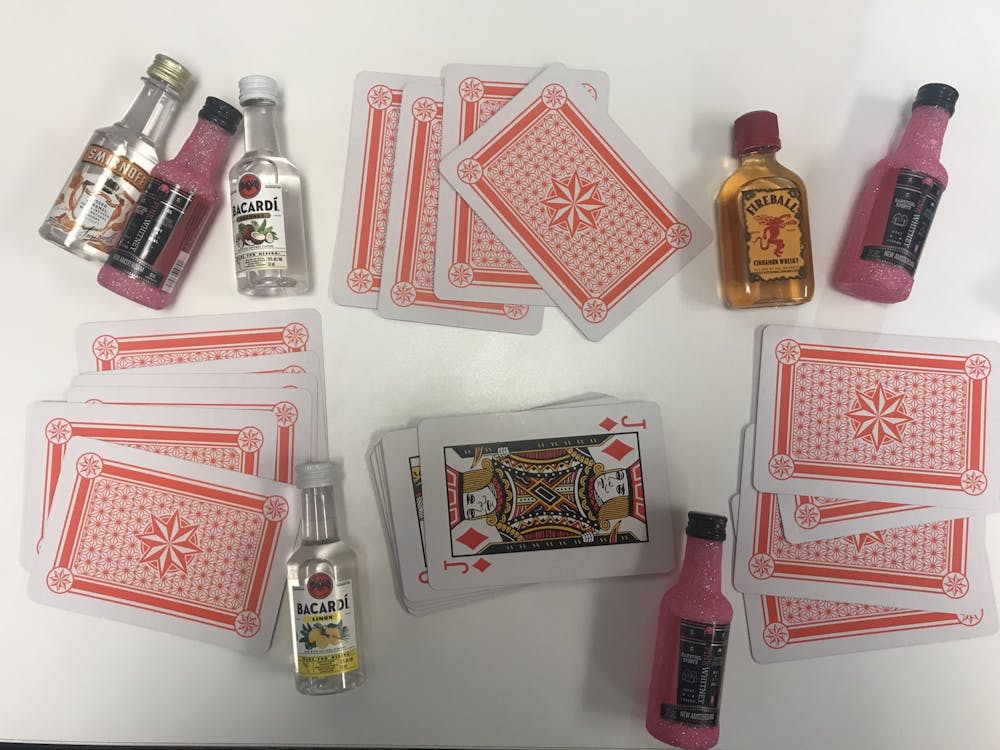College students crowd in a residence hall room, perched on desk chairs or huddled on the floor. They hold cans, bottles or red Solo cups of alcohol.
One member of the group, Kenan Osmanagic, however, holds no beverage, instead, a bag of Reese's cups. He recalls sitting among the group, surrounding a closed can with cards tucked under its tab, the rest of the deck sitting nearby.
They were playing Kings, a drinking game well-known to card decks at Miami University. A player pulls a card, each one prompts that player to drink, to tell someone else to drink, a certain group to drink, a new rule to be made or a game to be played.
Ace: waterfall. Two: you. Three: me. Four: floor. Five: guys. Six: chicks. And so on.
Once the rules are acted upon, the card-holder carefully places it under the can’s tab, threatening to pop the seal, seep air and prompt the card owner to drink it.
Another person then pulls a card. They yell in unison as the card is revealed.
Five, “Guys!”
All of the guys in the group take a drink, except Osmanagic — he simply reaches into his bag to pull out a singular Reese’s peanut butter cup.
Osmanagic, a junior independent studies major, has never been drunk and does not plan on changing that. He replaces the drinking aspect of the game with candy.
Friends helped to uphold Osmanagic’s preference during their first-year, preparing his bag of candy whenever they hosted a residence hall drinking gathering.
“I'm just glad that there were people there that were respectful of that,” Osmanagic said. “I just walked in [and] they’re like, here's his bag of Twix or whatever so that he can play the game with us.”
Enjoy what you're reading?
Signup for our newsletter

Kenan Osmanagic has never been drunk and attributes his success to a strong sense of self-identity.
Jack, “Never have I ever!”
Osmanagic’s experience with the prospect of getting drunk for the first time is not rare among college students.
According to data from The Office of Student Wellness’ required Alcohol Edu course modules, in 2021, 77% of incoming Miami first-years enter Miami as abstainers, nondrinkers or moderate drinkers.
Rebecca Young works to maintain that percentage as director of the Office of Student Wellness.
“When students [enter] college, it [becomes] harder to make those types of choices to either abstain or be a nondrinker or to drink in low-risk ways,” Young said. “So they would move to other categories like high [or] heavy episodic drinking or problematic drinking.”
Young said the highest reported reason that incoming students say they choose not to drink is due to a personal value.
Lucy Satheesan, a junior resident assistant (RA) and a computer science major, said she abstains from drinking because she won’t reach the legal drinking age in her college career.
“The major reason I don't want to drink is because I'm underage, and I graduate at 20. So I will never get to legally drink on campus,” Satheesan said. “And getting caught while drinking illegally is potentially ruinous because I'm an international student.”
Osmanagic said he doesn't see the purpose in alcohol.
“I never really was around the culture of, ‘You need to be drunk to have fun’ and all this stuff. So I was just like, ‘Who cares?’” Osmanagic said. “I didn't need it. I didn't feel like that was necessary to enjoy my life at all.”
Eight, “Mate!”
Osmanagic attended residence hall gatherings with drinking games like Kings for friendship. After his first year, though, the pressures of going out to bars became more prevalent. His friends were going out multiple times a weekend.
Although he wasn’t interested in drinking, he wanted to experience the large piece of Miami culture that his friends thought was fun.
“I think what really sparked me to really desire to go out with them is that I was their friend, and I wanted to experience that with them,” Osmanagic said. “So I was like, I want to just join you guys in that because I didn't understand the culture … Maybe if I just went, it would be fun, and I would have a good time.”
His first drinking-adjacent excursion beyond the residence hall was a trip to a Halloween house party sophomore year.
He hot glued pressed leaves together to make a cloak, which he paired with a green shirt, and green corduroy pants. Hair clips given to him by a “nearly naked” fairy, completed his mother nature costume.
He socialized among red-Solo-cup-bearing, costumed, drunk college students.
“It was fun. And everyone was like, ‘Oh my gosh, are you a tree?’ And I'd be like, ‘Sure,’ because I didn't really care. I just liked the costume,” Osmanagic said. “I enjoyed going there because I didn't get crazy. I didn't drink. I didn't do anything weird. I just sat around and talked to people.”
Satheesan felt similar pressures to go out. Friends convinced her to experience her first bar during RA training.
Three, “Me.”
Satheesan sat, enveloped by the loud chaos and packed crowds of Top Deck Bar. A spilled drink from the group behind her made her shoes stick to the floor.
“You can have successfully dragged me here, but you will not successfully force me to drink that,” she said, referring to the beer tower her friends had ordered, filled with frozen water bottles. “It feels unhygienic like, [did they wash] the bottles before they just immersed them into the beer?”
Satheesan took sticky, people-navigating steps to leave the company of her friends and their beer tower after what she estimates was 30 minutes.
Osmanagic isn’t one for the bar environment either.
“What really baffles me to this day, honestly, it's the whole club thing. I just don't really get it. I don't understand,” Osmanagic said. “There's this huge line of people and they wait and they pay way too much to get let into this dark room full of loud music that's busting their eardrums off.”
Osmanagic rode his bike to his first ever visit to Brick Street Bar on a “random Saturday.”
He secured his bike on the rack he uses for the farmer’s market and joined the long Brick line.
In an effort to socialize, Osmanagic remembers talking to others in line, telling them it was his first time at Brick.
“They just told me the same stuff everyone always tells me: that the floors are so gross,” Osmanagic said.
Four, “Floor!”
He paid the $10 cover charge to take his first steps on Brick’s well-trodden, sticky floors for the first time. The bar seemed to grow in front of him.
“This place is massive, dude, you could house an airplane in here,” Osmanagic said.
As he passed some people he knew from his first year and followed his groups of friends, he joined the dance floor. He danced with his arms free and inhibitions inexistent within the constraints of the packed dance floor and the music he didn’t like.
“Dancing is fun. You can't deny that. I love to dance,” Osmanagic said.
For students like Satheesan and Osmanagic, Young says the Office of Student Wellness seeks to show them that abstinence and bars can go together.
“The other thing that we want to make sure that students know is that they could go to the bars uptown if they'd like to, and they don't have to engage in drinking there,” Young said. “They can just enjoy the music, enjoy the camaraderie, dance, and they can do that by having some good skills on how to feel confident about not choosing to drink alcohol.”
Osmanagic still doesn’t entirely understand the bars or why people frequent them.
“Everyone is having such a good time, and I felt weird for being so judgmental of it. And I was like, ‘Why don't I? Why can't I just enjoy the music? Why can't I just enjoy myself?’”
He hypothesizes that this is one of the reasons many people drink.
“If something can only be enjoyable when you're drunk, is it really enjoyable in the first place?” Osmanagic said.
King, “Ruler.”
Osmanagic left Brick unimpressed.
“I don't really understand why I would do that. In place of, like, anything else, on my Saturday night,” Osmanagic said.
Satheesan sees the other side of the drinking culture as an RA, tasked with creating engaging events for her residents.
Last Green Beer Day (GBD), Satheesan held a game night in her hall. She watched residents leave and come back, all passing up her event. After two hours of waiting, a few residents joined her game night.
“It was potentially the worst decision I've made as an RA,” Satheesan said about the event.
The students, she said, had returned from the bars earlier than expected, reporting it wasn’t what it was cut out to be.
Young emphasized the Office of Student Wellness’s focus and success in the area of alternative late night events through Miami Activities and Programming (MAP).
“We're seeing more students choose to either abstain, or to delay their drinking because of these activities. So we invested more money,” Young said. “So there's about a $200,000 investment in making sure that students have really fun and engaging activities on campus, so that there is another option than maybe going Uptown to some of the bars.”
This GBD, MAP offered Spring-O, spring themed bingo.
Because of her experience last GBD, Satheesan said she avoids planning late night alternative events due to their low turnout.
“They're hard to get people for,” Satheesan said. “People might either [be] going out and partying or might have other plans or might want to sleep early, or any number of reasons that make it hard for people to show up for that.”
Two, “You!”
Osmanagic still opts to not drink alcoholic beverages when he is called upon to drink in games. He sometimes opts for a red Solo cup filled with water rather than the bag of Reese’s cups or Twix he was accustomed to his first year and is no longer limited to the small residence hall floor plans in his upperclassman apartment days.
He attributes his success to a strong sense of self-identity.
“I think I just grew up with the really strong idea that I don't need this stuff,” Osmanagic said. “I can make choices on my own, and I should, completely by my own volition, choose what I want to or not to do. And drinking is something I never felt the need to do.”




